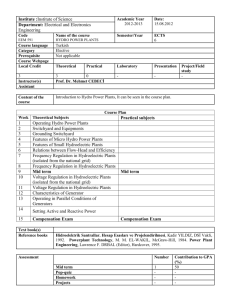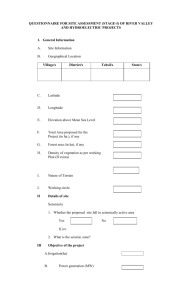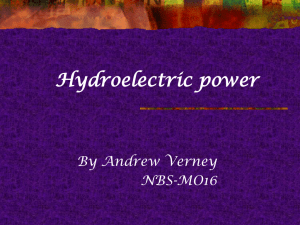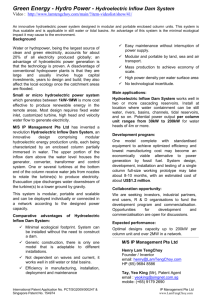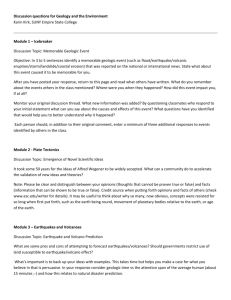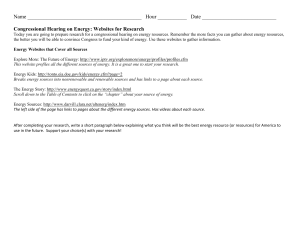hydroelectric projects development: challenges
advertisement
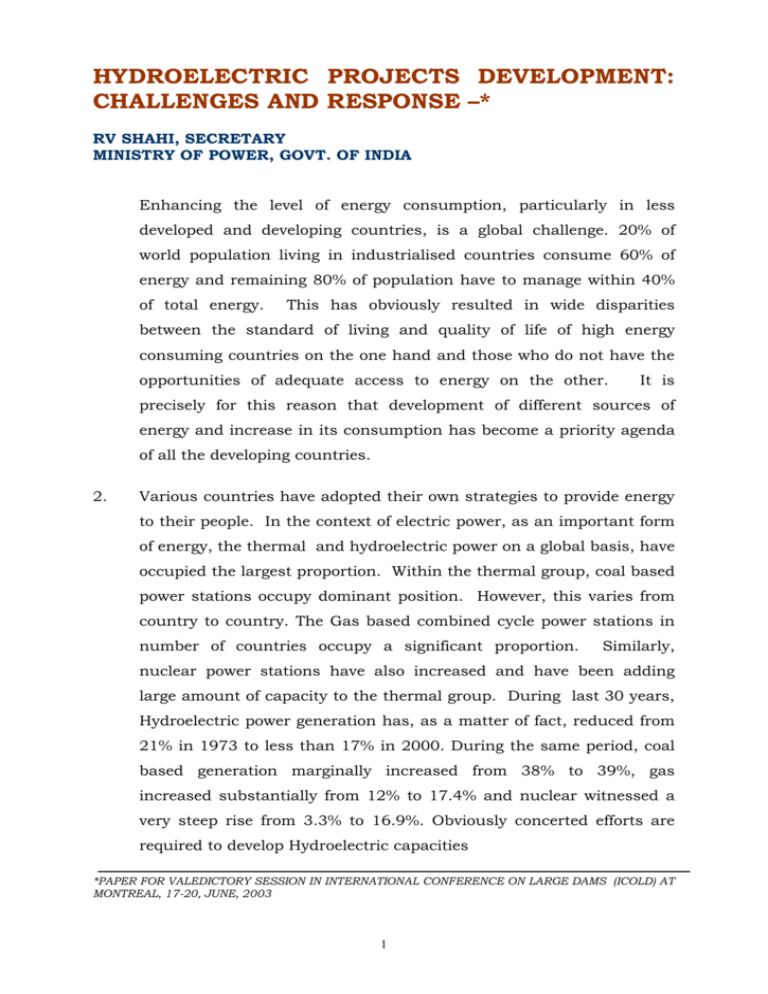
HYDROELECTRIC PROJECTS DEVELOPMENT: CHALLENGES AND RESPONSE –* RV SHAHI, SECRETARY MINISTRY OF POWER, GOVT. OF INDIA Enhancing the level of energy consumption, particularly in less developed and developing countries, is a global challenge. 20% of world population living in industrialised countries consume 60% of energy and remaining 80% of population have to manage within 40% of total energy. This has obviously resulted in wide disparities between the standard of living and quality of life of high energy consuming countries on the one hand and those who do not have the opportunities of adequate access to energy on the other. It is precisely for this reason that development of different sources of energy and increase in its consumption has become a priority agenda of all the developing countries. 2. Various countries have adopted their own strategies to provide energy to their people. In the context of electric power, as an important form of energy, the thermal and hydroelectric power on a global basis, have occupied the largest proportion. Within the thermal group, coal based power stations occupy dominant position. However, this varies from country to country. The Gas based combined cycle power stations in number of countries occupy a significant proportion. Similarly, nuclear power stations have also increased and have been adding large amount of capacity to the thermal group. During last 30 years, Hydroelectric power generation has, as a matter of fact, reduced from 21% in 1973 to less than 17% in 2000. During the same period, coal based generation marginally increased from 38% to 39%, gas increased substantially from 12% to 17.4% and nuclear witnessed a very steep rise from 3.3% to 16.9%. Obviously concerted efforts are required to develop Hydroelectric capacities *PAPER FOR VALEDICTORY SESSION IN INTERNATIONAL CONFERENCE ON LARGE DAMS (ICOLD) AT MONTREAL, 17-20, JUNE, 2003 1 3. Low Exploitation of Hydro Potential Inspite of hydroelectric power requiring a clean energy generation process, exploitation of Hydroelectric potential in various countries has been rather on a lower side. While the countries like Canada & Norway have exploited their hydro potentials to the extent of 48% and 58% respectively, Brazil has developed it to the extent of 31%, China and India both only to the extent of 18%. (MW) 4. COUNTRY POTENTIAL INSTALLED PERCENTAGE Norway 47,000 27,360 58 Canada 160,000 65,378 48 Brazil 170,000 52,427 31 China 310,000 56,000 18 India 150,000 27,000 18 Power Shortage in India In India, though over 100,000 MW of capacity has been added in last 50 years, there is a huge gap between the demand and supply of power. While in the last few years it has marginally reduced, the peaking shortage continues to be over 12% to 13% and the average energy shortage at about 8.8%. Indian power system has an installed capacity of 108,207 MW in May 2003, with hydroelectric accounting for 25%. Installed Capacity in MW (05/2003) Sector Hydro Thermal Wind Nuclear Total State 23,085 40,141 65 0 63,291 Private 876 9,419 1805 0 12,100 Central 3049 27,047 0 2720 32,816 Total 27,010 76,607 1,870 2720 1,08,207 2 5. Declining proportion of Hydro Capacity In the last 30 years, the proportion of hydroelectric capacity in the Indian power system has considerably reduced. It has dropped from about 46% in 1970 to 40% in 1980, 29% in 1990 and now 25% in 2003. In spite of the Hydroelectric potential, which is now estimated to be of the order of 150,000 MW, the exploitation has been of the order of 27,000 MW. Some of the important reasons for decline in the Hydroelectric proportion in the total capacity over the last 30 years are as follows: a) Indian power supply industry has always experienced the situation of shortages both in energy and peaking requirements. To tide over the shortage in shortest possible time, more dependence was placed on sources of power generation with shorter gestation period. Obviously this short-term approach rather than a long-term perspective led to this problem. b) With abundant coal reserves in the country, large capacity additions through coal based pithead power stations during the eighties and nineties increased the thermal proportion. c) Emergence of gas based combined cycle power stations based on indigenous natural gas with gestation period of 2-2 ½ years also received priority in response to the anxiety to create capacity addition in shortest possible time. d) Nuclear power stations have also emerged as reliable modes of thermal generation. e) In spite of best efforts at the stage of planning and formulating projects in the hydro segment, a number of large projects got into long gestation period of construction on account of various reasons, namely environmental issues, rehabilitation & resettlement (R&R) problems, gap between investigations and field realities, etc. We do have a number of successful stories on the hydroelectric projects but we also have large projects which have taken several years to get completed. 3 6. Thrust on Hydro Power In the recent years, the Govt. of India has committed quantum jump, in the financial allocation and also by way of other supports so that Hydroelectric projects not only get right priorities but also contribute in an increased way to the future capacity addition programmes of the country. Accordingly, in the 10th Five-Year Plan (year 2002-2007), the target for hydroelectric capacity has been placed 14,393 MW, which is more than the total installed capacity (13,666 MW) created in the last 20 years. The thrust on hydroelectric development is based on the following considerations: a) Hydroelectric involves a clean process of power generation. Once the projects are constructed, there is no pollution ramification unlike many other power generation technologies and processes. b) Since it does not suffer from the limitation of inflation on account of fuel consumption, in the long run, it is the most cost-effective option for power supply. In Indian context, where more than 45% of Indian population has yet to have access to electricity at an affordable price, this is an important consideration. c) Indian power supply system has a peculiar limitation of huge variation between peak and off peak requirements. Management of peak load in an effective manner could be conveniently handled through availability of hydroelectric support. The system at present does suffer from large frequency variations. Better hydro support could address this problem better. d) Locations of Hydroelectric projects in India are also in areas which need substantial support for their economic development. areas are North-east, Uttaranchal, Himachal Pradesh Kashmir where more than 80% of potential exists. These & Jammu & Developing projects in these areas will spur economic activities and will lead to overall economic development. e) In an integrated Hydroelectric project – there are many such projects – the schemes involve not only supply of electricity but also provision of drinking water and irrigation. These are important issues in many parts of India. Hydroelectric projects, in many cases, do have the ability to mitigate these problems. 4 f) Flood control is also an issue and quite often a challenge. Integrated hydroelectric projects could adequately address this concern. 7. Govt. of India Initiative on Hydro Power Development: The main features of the Government of India policy on hydro power development are as follows: Additional budgetary financial support for ongoing and new hydro projects under Central Public Sector Undertakings. Basin-wise development of hydro potential – comprehensive Ranking studies for 399 schemes. Advance action for capacity addition – 10 year ahead of execution Emphasis on quality of survey & investigations Resolution of inter-state issues on sharing of water and power. Renovation, Modernization & Uprating of existing hydro stations Promoting small and mini hydel projects – 25 MW and below now fall into category of “non conventional” qualifying for benefits. Simplified procedures for clearances by Central Electricity Authority; Electricity Act 2003 further liberalises this. Rationalization of hydro tariff by allowing premium on sale rate during peak period Realistic estimates of completion cost considering new development on geological front during execution. Promoting hydel projects in joint venture Selection of developer through MOU/Bidding route Govt. support for land acquisition, resettlement and rehabilitation, catchment area development, etc. Some of the measures announced by; Govt. of India have already been introduced which include simplified procedures for transfer of techno-economic clearances, streamlining of clearance process and introduction of three-stage clearance 5 approach for development of hydro projects in Central Sector/Joint Ventures, etc. The Central Electricity Regulatory Commission has approved 5% hydro development surcharge on annual fixed charges for central hydro power generation. 8. 50,000 MW Hydroelectric Initiative Apart from over 14,000 MW capacity addition which has been planned to be operational during the period 2002-2007, a 50,000 MW Hydroelectric Initiative has been launched by the Prime Minister of India in May, 2003. This initiative has started with the preparation of feasibility report and detailed project report. 162 hydroelectric schemes have been identified with an aggregate installed capacity of 50,560 MW. They are located in sixteen States of the country. Of these, 106 schemes aggregating to about 39,000 MW are located in only four States namely Arunachal Pradesh, Uttaranchal, Himachal Pradesh and Jammu & Kashmir. These projects under this Initiative are proposed to be taken up for execution during 11th & 12th Plans i.e. between 2007-2017. Report to Detailed All the preparatory works from Feasibility Project Report and also in many cases infrastructural development should have been done before that. 9. Major challenges and responses: Development of Hydroelectric projects has thrown up a number of important challenges, the world over and particularly in Indian context. Over a period of time, experiences have been acquired and India is responding to these challenges in the following manner. a) Impact on Environment: Hydroelectric projects do create environmental issues emanating from sub-mergence of large areas also involving forest. The Govt. of India has a comprehensive legislation on environmental issues and based on this legislation, there are well laid down principles and 6 guidelines. Environment Impact Assessment studies when properly carried out throw up the tasks to be undertaken by the project development agencies. Over a period of time, both the processes of a) studies and preparation of the plans to mitigate environmental impact and b) procedure of clearances from the authorities, have been streamlined. Process of improvement on these areas continues to see as to how best the adverse environmental impacts are mitigated and also the procedure does not lead to delays. It needs to be ensured that if the forest area is affected, sufficient amount of forest is created. Ministry of Environment & Forest is working on a plan to create Forest Bank which would entail creation of huge afforestation with funding from project development agencies in advance so that this issue could be adequately responded. The mechanism of compensatory afforestation through the Forest Bank will enable quicker clearances of projects. b) Rehabilitation & Resettlement (R&R) of Project Affected People (PAP) is another major issue affecting the smooth execution of Hydroelectric projects particularly where in submergence areas, the number of project affected people are large. Experience of last several years has brought about sufficient amount of understanding on the subject. The expectations of people, local authorities and project development agencies are being synthesised so that there is greater degree of acceptability of the system of R&R. Govt. of India is contemplating a national policy on R&R for Project Affected People. In the meantime, Ministry of Power of Govt. of India and its public sector undertakings are coordinating their efforts with the State Govts. so that R&R issues are adequately addressed and project implementation is smooth. In cases, where large projects are involved, specific monitoring mechanism has been put in place at senior most level in the Govt. so that proper implementation of R&R plans by project agencies is done in letter and spirit. 7 With the above experiences now, it appears that in future, the concerned project development agencies would evolve proper plans and programmes well in advance so that the mitigatory measures are adequate and project implementation is smooth. c) Another issue of concern is in relation to safety of dams. Here again, experiences from some of the very large projects of the country have led to considerable amount of knowledge base and it is expected that in future projects, studies and findings on dam safety could provide much higher degree of confidence. Some of the Indian institutions have equipped themselves both with hardware and software to properly address these concerns. Where required, project development agencies do depend on expertise available anywhere in the world for in depth studies and guidance. d) In view of complexity in development of Hydroelectric projects, particularly large submergence, ones, ramification emanating of from dam submergence, height, dam safety, drinking water schemes, irrigation, infrastructure etc., the process of clearances obviously gets linked with multiple agencies and authorities. Short cuts could create problems. Inordinate delays unaffordable tariff. struck. could entail huge cost and therefore Harmonious balance has, therefore, to be Here again, experience of last many decades has brought about a reasonable consensus on how to address this situation. The process of improvement on this front also continues. Procedures have been streamlined, and they would continue to be streamlined, to see that project development process, prior to commencement of main plant construction, by way of permission and clearances is made faster. Ministry of Environment and Forest, Ministry of Power authorities continue to search for better solutions. 8 and other e) Reliability of detailed project report needs to be enhanced. There are a number of examples in Indian Hydro project development context of large variations from estimated costs primarily on account of differences between the outcomes of investigations and ground realities. Both in respect of hydrology and geology, the quality of studies, investigations, analysis and findings need substantial improvement. The silver line is that there are recent examples of project development where variations are within limits. Experience gained here again must lead to qualitatively better DPR’s and estimates and project could be completed without cost over runs, at least with avoidance of such cost increases which are on account of variation in estimates germane to inadequacies in investigations. f) Construction time is another area of concern, which needs to be compressed. Large projects have taken inordinately long time. There are two major aspects which could make a difference – one is relating to construction management techniques starting from planning to monitoring and another relates to construction technology. Here again, there are recent examples of making substantial improvement on both the fronts. Some of the projects which have been sanctioned in the recent months are being targetted to be completed within 4-5 years. Based on the benchmarks which have been established, the techniques and technologies would be further improved. Choice of technology will have to be given serious consideration. For the next few years, project development agencies are being advised to target 4 years for completion of small projects, 4 ½ years for medium size projects and 5 years for large projects. These schedules are significant improvement over the past performance. After these results are achieved, the would be further improved. 9 norms g) Communication with press, media and people at large to reduce the communication gaps on merits of hydro-projects and on mitigatory measures is another area of challenge which is being addressed. This also needs to be taken up appropriately at global level. 11. Opportunities in Indian hydroelectric sector About 14,000 MW of additional capacity in the period 2002-2007 and 50,000 MW of additional capacity during the period 2002-2017 throw open enormous opportunities for national and international agencies. The opportunities fall in the following categories. a) Preparation of DPR for the 162 schemes with over 50,000 MW capacity 12. b) EPC contracts for development of many of these projects c) Package wise contracts in a large number of projects. d) Investment as equity holder and project developer e) J.V. with Indian Companies for developing projects f) Providing finance - opportunities for the funding agencies. Viability of Investments The main reason for somewhat lukewarm response for investments in Indian power sector in last ten years has been the poor financial health and creditworthiness of the sector With the reform and restructuring of Indian power sector, post Electricity Act 2003, which has been notified on June 10, 2003, during the next 3-5 years Indian power sector, even on distribution segment, could present itself to be stronger both technically and commercially. Implementation of the recently launched Accelerated Power Development & Reform Programme (APDRP) of the Government of India is expected to lead to financial viability of distribution business. 10 Based on these, investments in the sector, and more particularly in hydroelectric projects, which could provide comparatively inexpensive power in the long run, would be fully viable. The electricity market where competitive environment is being created, with multiple options of production and sale of power and where power trading is emerging as a distinct activity, power sector offers enormous opportunities. 11
